
Probes into racism in schools stall under Trump
IDRA has been supporting families and the Lubbock NAACP in Lubbock, Texas, since at least 2023 regarding persistent harassment and bullying against Black students in
See our new report: Progressing Backward U.S. South Policy Update – IDRA SEEN State-Level Legislative 2024 Recap and 2025 Preview
All students should be prepared for success in college so they can determine their own futures. Research on the 21st Century workforce indicates most jobs require some level of education beyond high school. Yet students of color and students from families with limited incomes continue to face barriers to rigorous college preparation, access and success.
Policies and practices that track students away from college or limit access to advanced courses take the power away from young people and families to choose their own paths.
Gaining access to college opportunities is vital for the success of Georgia’s students. Students’ educational opportunities are harmed when policies and practices track students to less rigorous coursework or assign them to their post-secondary path based on assumptions about their abilities. All students should be prepared and knowledgeable about how to access higher education if they so choose. Unfortunately, large disparities in attaining a college degree exist for students in Georgia based on race and ethnicity. Find out more about college preparation and access in Georgia.
All students deserve a high-quality education that prepares them for college and lifelong success. Schools have a responsibility to prepare all students to succeed in college, but not all students are meeting readiness benchmarks.
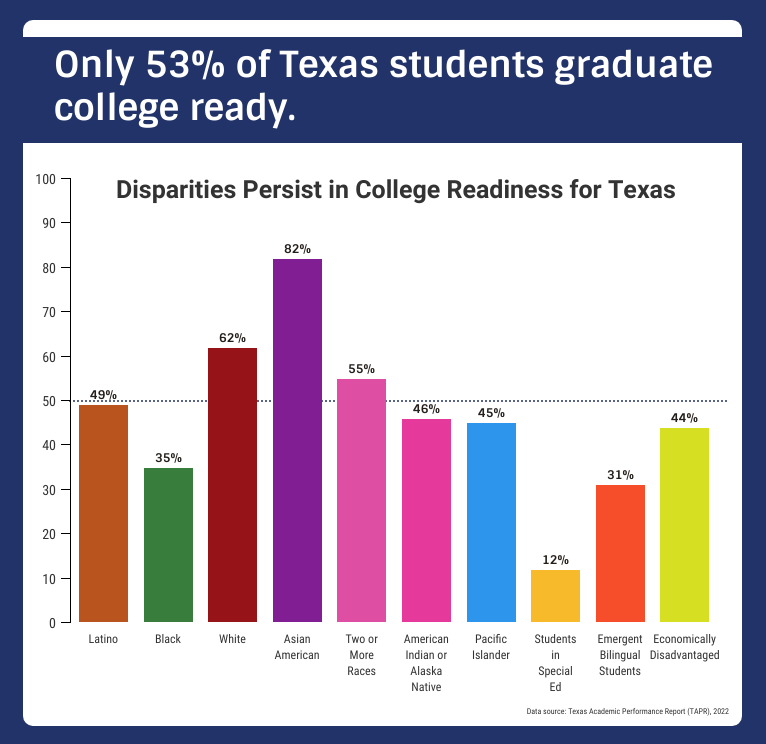
New tools about the Texas Dream Act changes:
• Navigating In-State Tuition in Texas High School Parents (English-Spanish), 2025
• Texas College Guide for Parents of College Students (English-Spanish), 2025
Report: College Bound and Determined Study of Pharr-San Juan Alamo School District
Infographic and Report: Ready Texas Study of Texas College Requirements
Texas Dreamers Won’t Be Silenced – IDRA and TxILC File Amicus Brief on Behalf of Business, Faith, Educator and Student Groups Urging the Fifth Circuit to Protect the Texas Dream Act , October 8, 2025
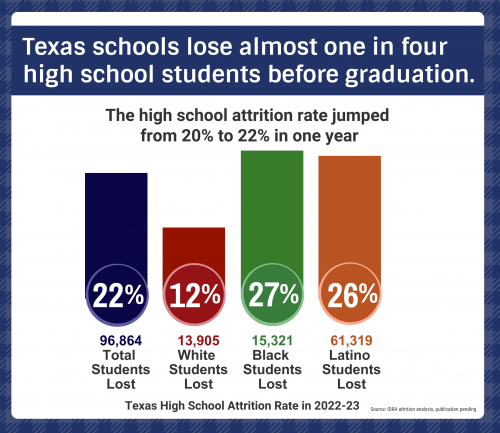
Emergent bilingual students are a significant – and growing – portion of the student population in school districts across the country. These students have so much to offer their schools and communities – they have the capacity to be bilingual and biliterate and to share their languages and cultures with their fellow students. Yet, they are often in underfunded school programs that do not support their academic achievement, with under-qualified teachers who are ill-equipped to track their progress.
English learner students (also known as emergent bilingual students) are valuable contributors to our communities, with the added asset of the potential to be bilingual, biliterate, and multicultural. Georgia is home to the eighth largest emergent bilingual population in the nation. Providing excellent education opportunities that ensure English mastery while honoring and supporting students’ home languages and cultures is not only good for students, families, and communities, but it is a civil right that must be protected. Find out more about emergent bilingual student education in Georgia.
Emergent bilingual students (English learners) make up nearly 20% of the Texas public school student population – over 1 million students. They are hurt by a number of policies and practices, including a lack of funding, shortages of qualified instructors, and incomplete data reporting about their progress and needs.

Strong programs for emergent bilingual students are well-funded, have high-quality teachers, and accurately track students’ progress and needs. But certified bilingual education teachers are in short supply and have been for over 30 years.
Now is the time to address the bilingual teacher workforce to support high-quality bilingual education programs for all eligible students.
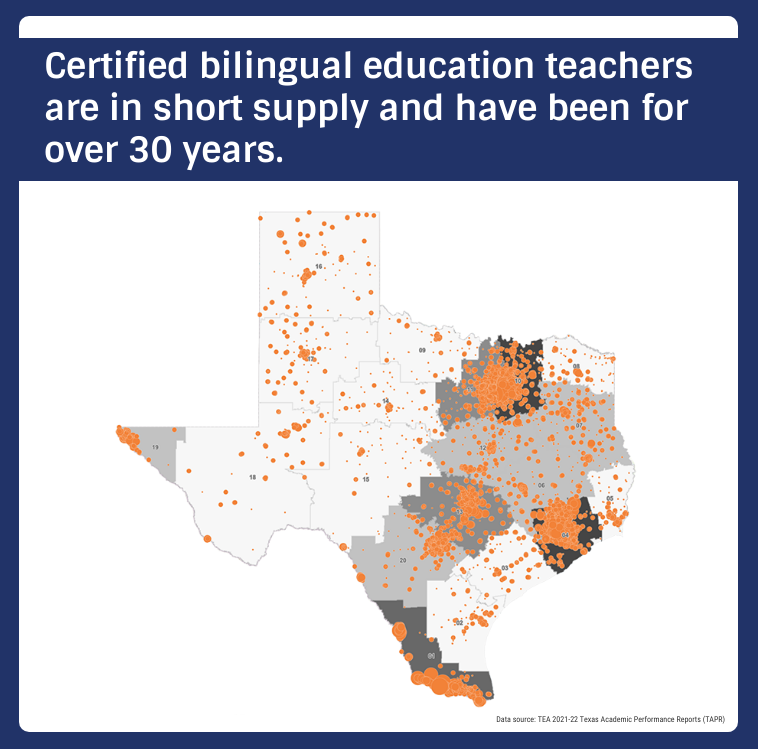
Issue Brief: High Quality Bilingual Education Programs
Need More Support to Realize State Goals, 2022
Creating a More Bilingual Texas, report by IDRA and Every Texan, March 2021
Dual Language Funding Issue Brief
English Learner Funding Data Dashboard
News Update: Breakthrough for students with bilingual and special education needs, September 30, 2025

Ethnic and cultural studies are much more than the heroes and heroines you hear about in traditional history books. Students examine the histories, experiences, cultures and issues of race to give a truer sense of history. Plus schools can shine a light on the massive contribution of racial and ethnic minorities in this country.
Furthermore, the research consistently shows that ethnic studies courses lead to improved standardized test scores, graduation rates, college attendance rates and academic mindsets.
Research consistently shows that ethnic studies courses lead to improved standardized test scores, graduation rates, college attendance rates and academic mindsets.
Learn more about IDRA’s efforts to promote cultural and ethnic studies.
Story and Advocacy Tips: Georgia Students Blocked from AP African American Studies, August 2024
See our infographic: Ethnic Studies Can be Life-Changing
See report by students: Student Research Team Calls for Expansion of Mexican American Studies
The Georgia Department of Education in 2020 approved seven cultural and ethnic studies courses available to Georgian students.
See our infographics for Georgia:
Students need safe and welcoming school environments to learn. Disciplinary practices that push students out of classrooms, physically punish them, or put them into contact with police officers are ineffective and harmful. These punitive strategies cause students to miss important learning and social time with their teachers and peers; can lead to trauma and disengagement from school; and increase the likelihood of grade retention, students dropping out, and contact with the justice system. This process of exclusion, punishment and poor outcomes is known as the “school-to-prison pipeline” or “school-to-deportation pipeline.”
Rather than punishing students, schools should focus on creating safe and welcoming campus climates that put students on the pathway to college and life success.
States throughout the U.S. South have some of the highest rates of discipline in the nation. As southern states rely on exclusionary discipline more than other states in the region, data show their rates of exclusion for students of color and students with disabilities are much higher than their proportion of the population. Additionally, states throughout the U.S. South have some of the highest levels of school surveillance and policing while having little access to counselors, social workers, nurses, or psychologists.
Georgia schools use suspensions, corporal punishment, alternative school placements, expulsions, and police officers to punish students. When schools rely on these harmful methods, they put students at a higher risk of repeating a grade, dropping out of school, and having contact with the juvenile and adult criminal justice and immigration systems – a process known as the school-to-prison or school-to-deportation pipeline. Find out more about creating safe and welcoming pathways for all students in Georgia.
All students deserve safe and welcoming schools that do not use harmful discipline and school police to punish young people. To achieve this, schools must be able to invest in the people and programs that build strong campus climates and foster the relationships that keep everyone safe.
Yet, Texas is still one of 19 states that allow corporal punishment of students and regularly incorporates ineffective and costly school surveillance strategies that do more harm than good.
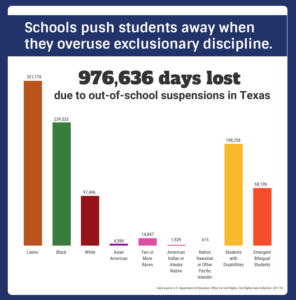
Corporal punishment is still legal in schools in 21 states, with more than 106,000 children receiving corporal punishment during the 2015-16 school year. Black students disproportionately receive corporal punishment in schools as well as students with disabilities, making this a key racial justice and educational equity issue.
Southern states are among the minority of states nationwide that allow and actively use corporal punishment.
Hitting Hurts – The Case for Ending Corporal Punishment in Texas – IDRA Issue Brief, by Morgan Craven, J.D., April 2023
Corporal Punishment in Texas Public School Districts – IDRA Map

To develop safe and healthy school environments, schools must be able to respond to bullying and harassment appropriately and take deliberate action to prevent it. This includes incidences where the bullying taking place is based on or related to a student’s identity, such as their race, ethnicity, national origin, sex, gender, religion or disability status.
Students across the country have been increasingly reporting alarming examples of identity-based bullying in schools – fueled in part by misinformation spread as a result of recent efforts to attack and undermine diversity, equity and inclusion efforts in education.
Bullying and harassment jeopardize students’ ability to learn and undermine a school’s climate, leaving many students, staff, and communities feeling unsafe and disconnected (Craven 2022).
We must ensure that students, school communities and parents have the necessary tools to prevent and address identity-based bullying and can support all students impacted by it.
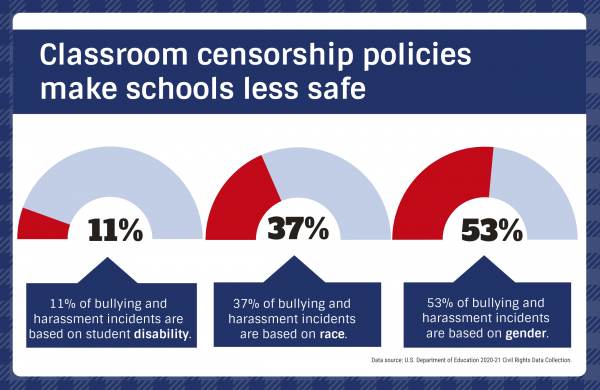
Every public school should have the resources it needs to provide an excellent education to all students, including emergent bilingual students and students in families with low incomes. To do this, states must fund all public schools adequately and equitably. Unfortunately, schools in Texas, Georgia and throughout the U.S. South are funded much lower levels than schools in other parts of the country.
Although Louisiana and Virginia have hovered around the national average, as of 2017 all Southern states are below the national average. Several factors contribute to this disparity including outdated funding formulas and a lack of political will to fully fund education systems. States decide how much to spend on education based on formulas that allocate certain amounts to school districts based on their populations of students (per-pupil spending). Many southern states have not allocated the full amount called for in these formulas.
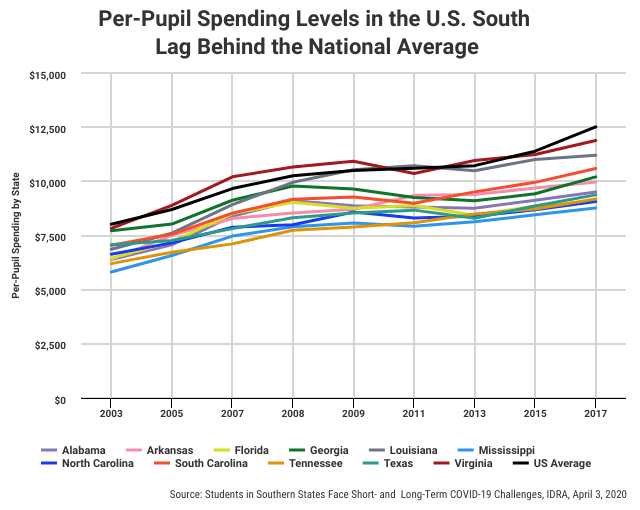
Georgia does not adequately fund public schools. The state has not conducted a comprehensive cost study to understand modern costs associated with education, and it has historically and currently funds education at a level that is below the average of other states in the South and across the United States. This systematic lack of funding deprives students in Georgia of the resources they need to thrive and successfully prepare themselves for college and career. Find out more about fair funding in Georgia.
Texas has a two-tiered, unjust public school system that provides poor or mediocre education for most children and excellent education for a select few.
Until the backwards steps in the early 2000s, many schools were beginning to reap the benefits from the state’s earlier commitment to equalize education funding for all of its children. Student achievement improved, taxpayers were more equally sharing the cost of paying for public schools, and businesses were seeing the results of better-prepared graduates.
After a 12-year span of more equitable school funding, changes were made that weakened the system, privileging a few children to the detriment of many. This was followed by huge unnecessary funding cuts that are crippling our schools. The Texas Legislature made significant improvements in 2019, but the state is not where it needs to be.
State funding for public schools remains below 50% and does not account for inflation or actual costs of education.
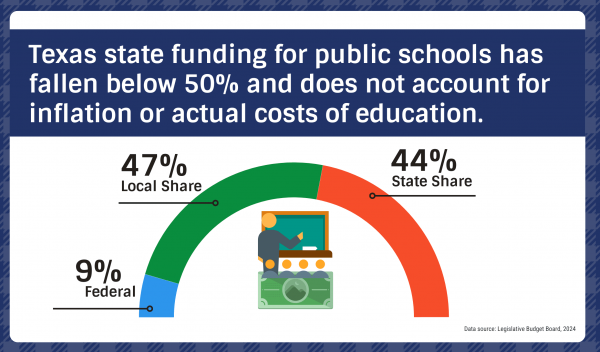
Policies that funnel much-needed resources to charter schools, private school vouchers, and other similar programs hurt traditional public schools and the students and families they serve.
Traditional public schools receive public funds, are operated by publicly-elected school boards, and should be held accountable by the communities, families and students they serve. Public governance, engagement and accountability are critical parts of ensuring strong schools for all students.
Unfortunately, there is a growing movement to invest in charter schools, voucher programs, education savings accounts, and other programs that funnel money away from the public schools that are open to all students, toward privately-run schools and individual families. In the summer of 2025, Congress passed a presidential priority to create a federal voucher program for across the country.
Civil Rights Talking Points: Federal and State School Vouchers: Impacts on Student Civil Rights – Talking Points for Education Advocates. These talking points were developed by civil rights and educational justice organizations and focus on the threats vouchers pose to students’ civil rights and access to equal educational opportunity.
Article: School Segregation through Vouchers – What Policymakers Can Learn from a History of State Efforts to Use Vouchers to Avoid Integration, by Paige Duggins-Clay, J.D.
Infographic: 5 Reasons Private School Vouchers Would Hurt Students
eBook: School Dollars Diverted in 2023 A Scan of Private School Voucher Legislation in the U.S. South, by Terrence Wilson, J.D.
Public schools are publicly-funded, publicly-governed institutions meant to educate all students. Yet, increasingly, Georgia public schools’ limited dollars are being diverted to privately-run programs that have little public oversight and accountability. While proponents of these programs complain about under-performing public schools and argue that equity and family empowerment can be achieved through “school choice,” real family empowerment and student success stem from strong public schools, not private choices for a select few. Find out more keep the public in public education in Georgia.
Map: Dispersed Private Schools by Georgia Senate and House Districts
Texas has repeatedly defeated school privatization efforts that would reduce the resources flowing to its neighborhood public schools.
Despite opposition by a broad coalition of students, parents and public school advocates, Texas passed a universal school voucher program that will go into effect soon. It is a billion dollar program that its cost will balloon to $10 billion dollars by its fifth year.
Infographic: Texas’ Newest School Voucher Law

IDRA has been supporting families and the Lubbock NAACP in Lubbock, Texas, since at least 2023 regarding persistent harassment and bullying against Black students in